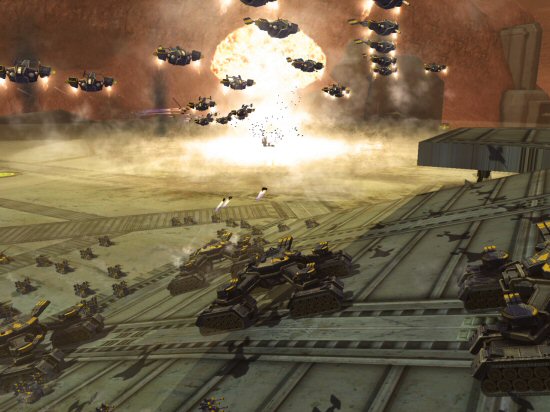A new dimension in RTS gaming?
If you are lucky to find a couple of decent opponents, the rest comes down to the gameplay itself – and I’ve got to say, it’s a cracker. The units are generally well-balanced, the research tree is well thought out, with sufficient options to make the game interesting without becoming confusing, the experimentals are great fun to deploy in battle, and there’s sufficient depth to keep a match competitive from beginning to end without degenerating into a “who can build the most tanks” battle with air, naval and land units, long-range artillery, experimentals, and ultimately nuclear weapons keeping the tactics fresh. I could easily end the review here, focussing on the plus points of the gameplay, but Supreme Commander 2 always leaves me feeling a little bit dissatisfied.The problem is that Supreme Commander was a trendsetter. It didn’t follow the well-trodden path that other strategy games had gone down – it dared to stand out and be different. When following up a game like that, Gas Powered Games were always going to struggle. They had only two ways to progress: if they’d copied the original, they would’ve lost the uniqueness that won them so many plaudits, but if they’d tried something new and experimental again, they would’ve seriously risked alienating their core support. Inexplicably, they ignored those two, and elected instead to go backwards and copy the “generic strategy game” model – simultaneously losing the uniqueness of the first and risking alienating their core support.
 Click for larger image
Click for larger imageGone are the complicated economics of the first, replaced instead with basic mass and energy collection and near-limitless storage – and whilst mass “mines” are rare on the map and imply the need to expand your territory and capture them, you quickly discover that energy is produced by cheap, unlimited power stations, and is easily converted into mass. Not particularly awe-inspiring. Gone are the mind-blowing experimentals that were a huge gamble, took a massive amount of preparation, and could tear opposing armies to shreds, replaced by inferior equivalents that are easier and quicker to produce, feel much less satisfying to deploy, and are much less of a threat. Gone are the monolithic battles that defined Supreme Commander, with opponents striving to gain a grip over the battlefield endlessly until they developed a winning strategy, poured all of their resources into it, and ultimately delivered a game-ending hammer blow. These do have the desired effect, making the game much easier to master and far quicker to play, but it’s at too high a cost. Something in between the two extremes was needed here, but the balance just isn’t there.
Ultimately, Supreme Commander 2 is well worth playing, but only if you’re a fan of multiplayer. The hashed-together single-player component is a massive let-down, and the gameplay is too generic for my liking, but there’s a lot here to enjoy if you’re prepared to play around the limitations.
User Review Score - 7.5/10
If you'd like to contribute to HEXUS.gaming and have a short review of your own published then please visit this forum. Read the rules, check to see whether the game you want to review is included in the list and then simply write it up on the forums. You'll have to be a registered user to join in, but it only takes a minute to join.
We're still accepting reviews for Supreme Commander 2, which will be added to this article.













